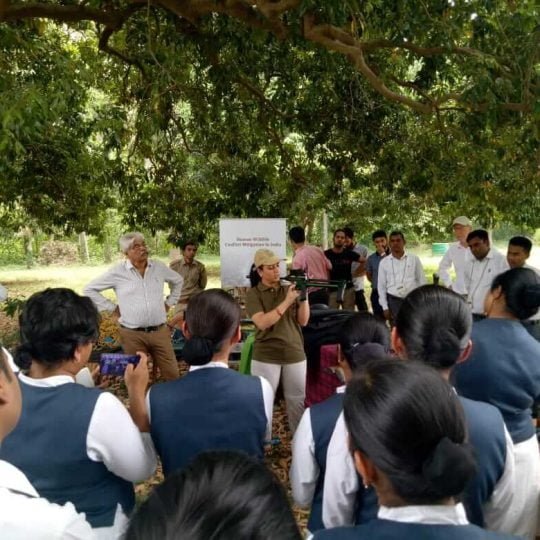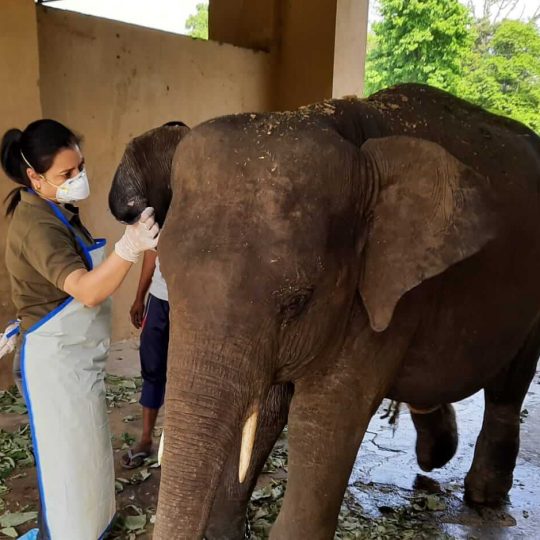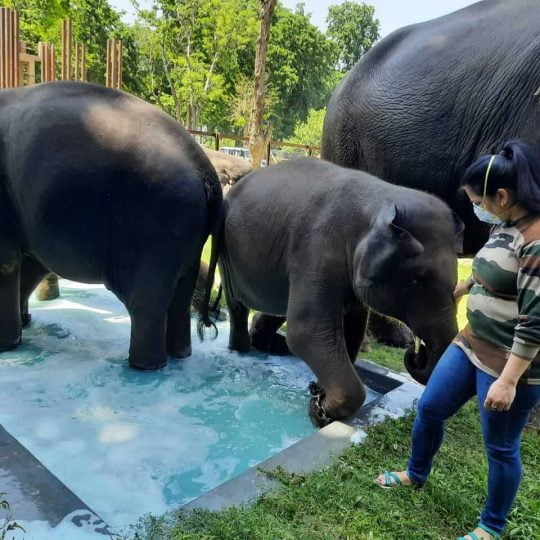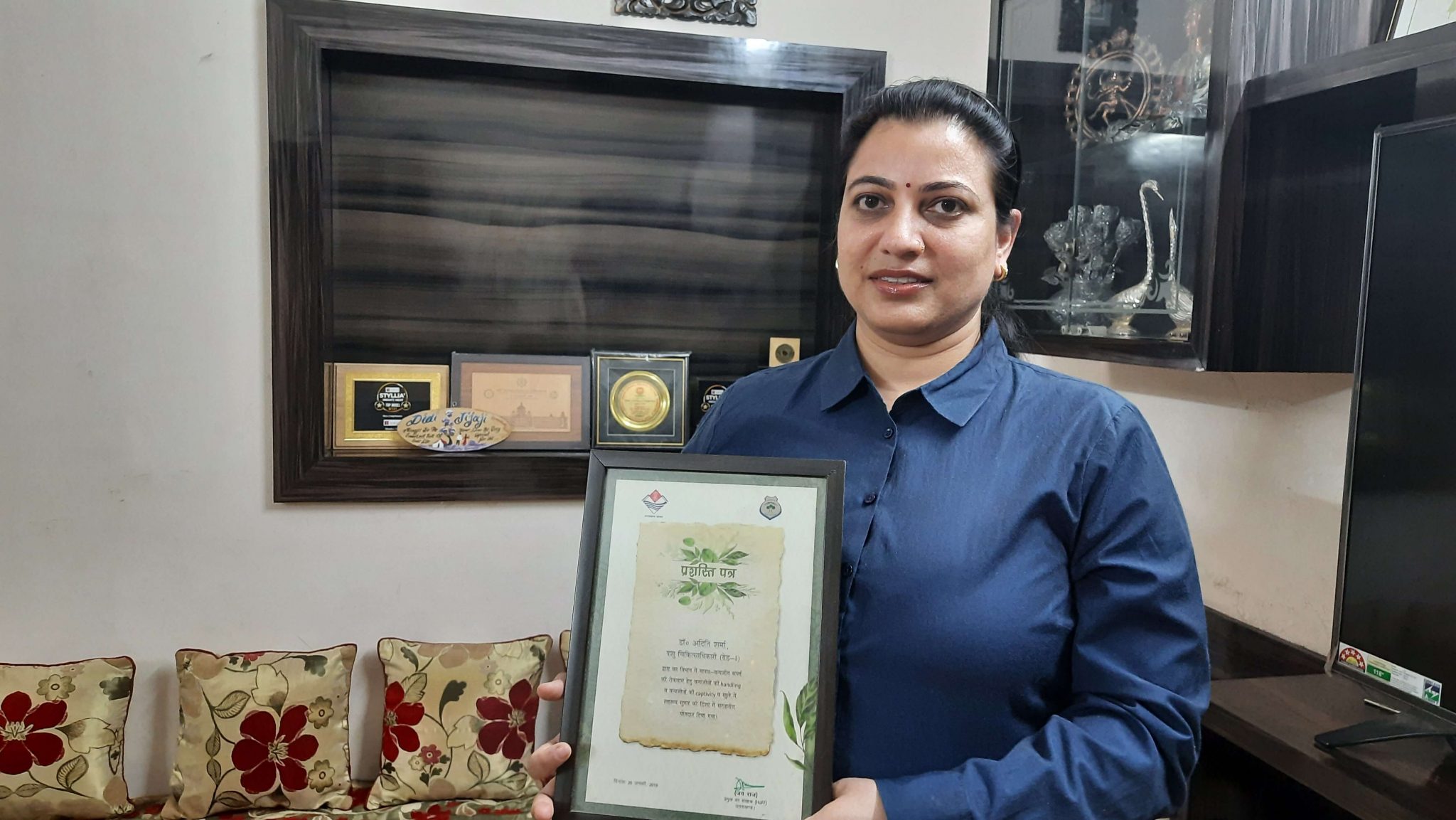Posted by Varsha Singh
“The operation was to catch a leopard that was hiding in the lower storey of a two-floor cowshed in Tehri Garhwal’s Narendra Nagar town. It was a dilapidated house. We were trying to target the leopard from the upper storey through a small window. No matter what, I had to get the beast sedated in order to rescue him safely. It took us several hours. But finally, we had him.”
A senior veterinarian and wildlife health specialist at the Rajaji Tiger Reserve in Uttarakhand, Dr Aditi Sharma has numerous interesting tales to recount of her encounters with the tigers, leopards and elephants.
Some are terrifying and some are moving – tranquilizing a man-eater leopard in the middle of the night, keeping vigil from a dais on a tree in a dense forest or tending to an elephant injured in a train accident. She further describes what happened after the Narendra Nagar operation,
“The women standing there hugged me as soon as I emerged out of the house after pacifying the leopard. They were crying. The leopard had been squatting in the cowshed for over 24 hours and the entire neighbourhood was terrorised. The way they embraced me and expressed their emotions, I felt that I had done something really big.”

Bravery Comes With Rigorous Training
The ride to recognition, however, was not easy. She had to overcome many hurdles before even being allowed in the vicinity of the wild animals.
Her teachers could not even picture the girls pursuing the veterinary course being able to face these dangerous animals. They would advise the girls to build a career in the teaching, laboratory or research aspects of the course.
But Dr. Sharma, with her grit and courage, proved her teachers wrong by confronting and taming the dreaded animals.
After her degree in 2001 and a Masters in Veterinary Surgery in 2004 from the Pant Nagar College of Veterinary Sciences, Dr Sharma began her career in 2005 by joining the Uttarakhand Animal Husbandry Department as a Veterinary Officer; ten years later, she moved to the Uttarakhand Forest Department as a Senior Veterinary Officer. The nerve and the skill to tackle ferocious animals had to be acquired slowly, through sustained rigorous training.
In 2014, she enrolled in Wildlife Health Management training from the Wildlife Institute of India and three years after that, she went to Malilangwe Wildlife Estate in Zimbabwe to be trained in the Chemical and Physical Restraint of African Wildlife. She then pursued an advanced degree from the University of Pretoria in South Africa. In 2019, she travelled to the National Elephant Institute of Thailand to learn about the health, reproduction and parturition of the tuskers. She also learnt all about the management, rescue and rehabilitation of tigers from the National Tiger Conservation Authority.

Despite her exhaustive training, Dr. Sharma continued to endure misgivings about her potential. As the first woman wildlife medical officer in the Uttarakhand Forest Department, this has been her constant experience.
“Even after my appointment in the Rajaji Tiger Reserve, the authorities were hesitant about entrusting me with crucial tasks. Once, an elephant was badly injured in a train collision. I was trained to deal with it but the reluctant forest department officials initially wanted to call a senior officer instead. Finally, I insisted that I treat the elephant because I was confident of my abilities.”
Dr. Sharma’s male colleagues were in a quandary. Eventually the woman veterinarian made them realise that it was unexceptional for her to discharge her duties. Gradually, she gained their confidence. In 2014, when the incidents of human-wildlife conflict increased in the Rajaji Tiger Reserve, with a sudden spike in the attacks by leopards and bears, Dr. Sharma played a significant role in identifying and capturing the animals.
A Windfall Of Awards
Former Chief Conservator of Forests in the Uttarakhand government, Jai Raj told 101Reporters, “Across the country, there are only a few women handling wildlife health management. And Dr. Aditi Sharma is one of those who doesn’t shy away from formidable challenges like restraining a wild elephant or confining a leopard. She has been awarded for her endeavours by the forest departments across the country. She has a specialisation in elephants.”
Her male colleagues may have taken time in realising her capability, but her family has always stood behind her. Speaking to 101Reporters, her husband and Assistant Professor at Doon Medical College Dr Sudhir Chand Sharma affirmed, “She believes in getting work done, even if she is required to stay in the forests for a long time. That too in the dense forests with no cellular network that I can’t enter even in the daytime. But Aditi isn’t afraid of anything.”

Her daughter might be fearless but Pushplata Sharma still gets nervous whenever Dr. Sharma has to venture into the forest, “I get anxious about her safety, but she has proved there is indeed nothing that girls cannot do.”
The brave wildlife health specialist is now inspiring others to step into the forest. Dr Sharma’s junior in the college and a doctor posted at the veterinary hospital in Tehri’s Kirti Nagar, Preeti Pandey said, “Following her, we also want to work with wildlife. Aditi is doing an outstanding job not only among women but the male veterinarians also.”
For her next project, Dr. Aditi Sharma is researching zoonotic diseases with the HNB Doon Medical University. Her paper, titled ‘Assessment of Infectious Zoonotic Diseases: the One Health Approach’ strives to identify wildlife diseases that could precipitate a Corona-like epidemic. Dr Sharma revealed, “Nowadays, nearly 60 percent of infections turning into epidemics originate from animals and 75 percent of those stem from wildlife.”
Also read: Hands On: A Documentary On Climate Change By Five Women From Four Continents
This article is a part of 101Reporters’ Rukhmabai Fellowship Stories About Women In Stem and has been re-published here with consent. In this series, 101Reporters cover the inspiring work of Indian women in the fields of STEM.
About the author(s)
101Reporters is a pan-India network of grassroots reporters that brings out unheard stories from the hinterland.





